Concept Corner: Yokai (Or "Oh Jesus I'll never look at Golduck the same way again")
/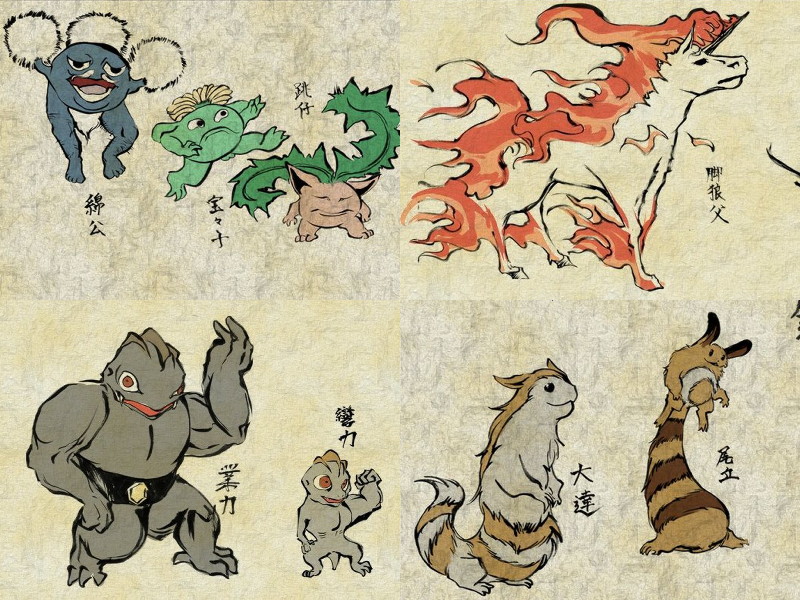 Yokai. Oooooohhhhhhhh boy...Before I begin, let me give credit where it is due. There is an absolutely delightful blog on Tumblr, which I will not link to due to profanity in its name, is known as "*cencored* Yeah Yokai" (Not hard to fiogure out the actual name, should you wish to check it out for yourself). This recent blog contains large amounts of interesting information on Yokai, the Japanese mythological material of the day, and mentions Pokemon in several instances. Its a great add to your Tumblr feed if you enjoy mythology in small snippets. Also, thanks to Nina Fichera, frequenter of the site and fan of the podcast, for bringing a couple of these to my attention, as well as helping me get my information together quicker about the Tsukumogami.
Yokai. Oooooohhhhhhhh boy...Before I begin, let me give credit where it is due. There is an absolutely delightful blog on Tumblr, which I will not link to due to profanity in its name, is known as "*cencored* Yeah Yokai" (Not hard to fiogure out the actual name, should you wish to check it out for yourself). This recent blog contains large amounts of interesting information on Yokai, the Japanese mythological material of the day, and mentions Pokemon in several instances. Its a great add to your Tumblr feed if you enjoy mythology in small snippets. Also, thanks to Nina Fichera, frequenter of the site and fan of the podcast, for bringing a couple of these to my attention, as well as helping me get my information together quicker about the Tsukumogami.
With that out of the way, let's begin. Yokai are a class of supernatural beings in Japanese mythology, ranging across a huge number of creatures from the commonly-known Ogre to lesser-known ones such as the Yuki-Onna, which those of you who read my mythology article from a while ago may remember as the basis for Froslass. Yokai are powerful creatures, usually bearing great supernatural abilities. Yokai often posess objects or bear animal-like appearences to conceal themselves from humans, making them an excellent leaping-off point for a surprisingly large number of Pokemon. Today we talk about some of those Yokai, as well as touching upon the Pokemon created from them.
Before I begin, let me give some words of warning. While I work hard to keep these articles G or at least PG, the nature of Yokai mythology is a bit gruesome. If you are easily disgusted or offended, this may not be the best choice of reading material. Extremely violent tendencies are very common in Yokai, and I feel I would be leaving interesting material oiut by not including this. Anyway, with that, it's time to suspend some disbelief and jump in!
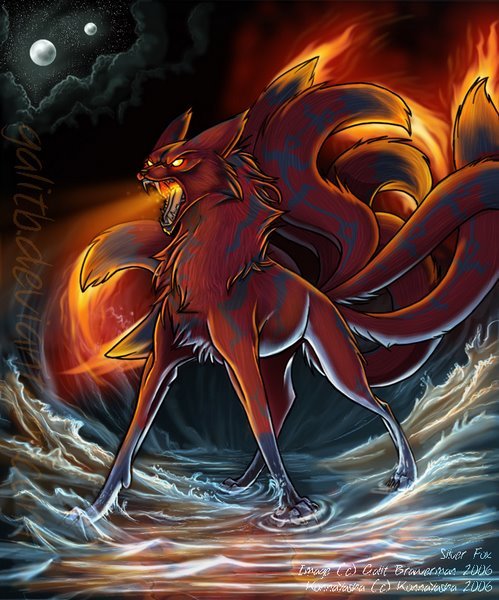 Kitsune
Kitsune
Take a look at this guy here. What do you think of? As a Pokemon nerd, you probably think of a Ninetales. Ninetales is both physically and asthetically based on the Kitsune, a magical foxlike creature with very high intelligence, as well as the ability to transform into humans. Kitsune grow in magic power as they age, as indicated by their number of tails, nine being the maximum number. If you meet a nine-tailed Kitsune, you don't want to mess with it. Some Kitsune even have the ability to posess human women through their fingernails or breasts, in a process called Kitsunesuki. A victim's symptoms include eyes that become foxlike, a hunched-over appearence, and a craving for tofu and rice, said to be a Kitsune's favorite food.
One of the most prominent and famous tales based around Kitsune is that of Kuzunoha. In this story, a young nobleman named Abe No Yasuna is severely wounded while saving the life of a fox that had been trapped by a military hunter, who had been hunting foxes in order to use their livers for medicine. The fox, after running off, transforms into a human woman named Kuzunoha. She then returns to the man and helps him to his home. The two fall in love and marry, and Kuzunoha bears a child, named Seimei. Seimei is extremely clever, proving himself to retain some of his mothers supernatural ability. Years later, Seimei accidentally sees the tip of his mothers tail. His mother discovers this,a nd decides that she must leave her family and return to the wild. She leaves behind a farewell poem before she goes, asking her husband to come see her in Shindoa forest. When Yasuna and Seimei come upon the shrine of the forest, Kuzunoha appears, as a fox, revealing herself to be the godlike spirit of Shindoa forest. In a final act of love, as well as remorse for the secret she has kept, she gives her son the gift of understanding animals.
Ninetales has 9 tails to Vulpix's 6, indicating a maximum level of power. Kitsune are commonly known to breathe fire, create illusions, and take on spirit forms when they die, the latter of the three relating to Ninetales' ability to learn ghost- and psychic-type moves.
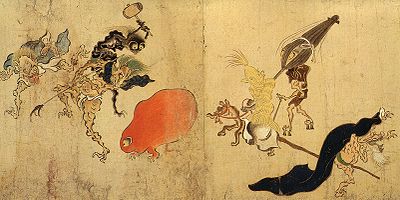 Tsukumogami
Tsukumogami
Remember a few days ago when we talked about Rotom? Well, we're there again. When I told my freind Nina, mentioned at the beginning of the article, taht I was going to write about Yokai-based Pokemon, she pointed me to this interesting little gem.
Tsukomogami are a kind of Japanese spirit, known to originate from inanimate objects and artifacts that have lasted for over a hundred years, coming from the Japanese cultural concept of objects becoming intelligent and aware upon reaching their 100th "birthday". Such objects may become abandoned over time, and these objects become malicious and turn into Tsukomogami. The results vary from objects with cracks that become mouths with sharp teeth to appendages and faces grown from them, similar to the plasma "arms" on the Rotom forms. The fact that the objects that become Tsukomogami are usually abandoned also ties into Rotom, as Rotom's various form-changing machines were abandoned by Charon.
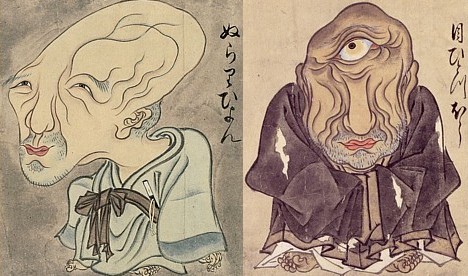 Nurarihyon
Nurarihyon
WOW is that ever hard to spell. Nurarihyon is the inspiration for Jellicent, whose female form gets my vote for creepiest gen 5 Pokemon. Nurarihyon is a creepy little critter, depicted as either a demonized jellyfish or a human with a bloated, gourd-shaped jellyfish-like head. In its human depiction, Nurarihyon wears very refined-looking clothing, is often known as the boss of all Yokai, and is known to enter a persons house while that person is away, drink their tea, and pose as the owner. Anyone who sees him will think him to be the owner of the house, making him very hard to get rid of.
Jellicent is also based on Kurage no Hinotama, a jellyfish-like will-o-wisp phenomenon seen in the waters of swamps and marshes, as well as the Crown Jellyfish, a kind of jellyfish with a deep groove running around its umbrella creating a crown-shaped head. This, combined with Nurarihyon's regal clothing, are inspiration for Jellicent and Frillish's frills and regal appearence.
Kappa
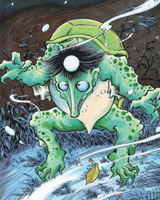
Kappas. Oh dear.
I hate Kappas. They look disturbing, and their traits and common activity are nothing less. They look freaky, they act EXTREMELY freaky...I don't like them. Described as impish, childlike creatures with webbed feet, scaly skin, and froglike bodies. Kappa are often depicted as, for lack of a better term, horny, constantly trying to get peeks at naked women. They will rape whoever, whatever, wherever, and whenever they please. They are also vicious killers, their favorite prey being human children. And would you like to know HOW they feed on this prey?
They suck their intestines out through their butts.
JESUS. I'm sorry, I need a minute.
...OHkay, on with it. Kappas have a bowl-shaped indent in their heads, which is always kept full of water. This basically acts as the Kappa's brain, and a Kappa will be rendered immobile if the water is spilled. Many humans in mythology have used this to their advantage. Kappas are traditionally very polite, and can be tricked into bowing, causing the water to spill off of their heads. If the human refills the kappas head, that Kappa will be forever indebted to that human. Once under a humans employ, a Kappa will have to take on whatever tasks its master wishes, often including irrigating farmland or making medicine, a practice at which Kappas show natural talent and skill.
So why are we ending the article with a discussion of Kappas? Because Golduck, yes, Golduck, is a Kappa. A highly stylized and adapted Kappa, but a Kappa nonetheless. It has the humanized duck appearence, webbed feet, and beak akin to Kappas.
Steve, hold on to that master ball for JUST a minute. Think about the creature you are about to capture.
I'm done. XD
Staring into space,
I'm IatosHaunted, tearing down the fourth wall once again.
Concept Corner is (c) Jay Petrequin, 2011
